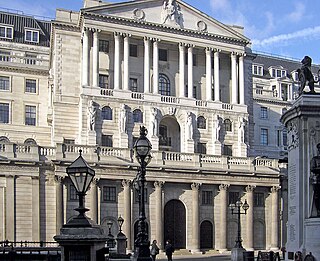
An overdraft occurs when something is withdrawn in excess of what is in a current account. For financial systems, this can be funds in a bank account. In these situations the account is said to be "overdrawn". In the economic system, if there is a prior agreement with the account provider for an overdraft, and the amount overdrawn is within the authorized overdraft limit, then interest is normally charged at the agreed rate. If the negative balance exceeds the agreed terms, then additional fees may be charged and higher interest rates may apply.

Barclays Bank Ltd v Quistclose Investments Ltd[1968] UKHL 4 is a leading property, unjust enrichment and trusts case, which invented a new species of proprietary interest in English law. A "Quistclose trust" arises when an asset is given to somebody for a specific purpose and if, for whatever reason, the purpose for the transfer fails, the transferor may take back the asset.
In law, set-off or netting is a legal technique applied between persons or businesses with mutual rights and liabilities, replacing gross positions with net positions. It permits the rights to be used to discharge the liabilities where cross claims exist between a plaintiff and a respondent, the result being that the gross claims of mutual debt produce a single net claim. The net claim is known as a net position. In other words, a set-off is the right of a debtor to balance mutual debts with a creditor.

English trust law concerns the protection of assets, usually when they are held by one party for another's benefit. Trusts were a creation of the English law of property and obligations, and share a subsequent history with countries across the Commonwealth and the United States. Trusts developed when claimants in property disputes were dissatisfied with the common law courts and petitioned the King for a just and equitable result. On the King's behalf, the Lord Chancellor developed a parallel justice system in the Court of Chancery, commonly referred as equity. Historically, trusts have mostly been used where people have left money in a will, or created family settlements, charities, or some types of business venture. After the Judicature Act 1873, England's courts of equity and common law were merged, and equitable principles took precedence. Today, trusts play an important role in financial investment, especially in unit trusts and in pension trusts. Although people are generally free to set the terms of trusts in any way they like, there is a growing body of legislation to protect beneficiaries or regulate the trust relationship, including the Trustee Act 1925, Trustee Investments Act 1961, Recognition of Trusts Act 1987, Financial Services and Markets Act 2000, Trustee Act 2000, Pensions Act 1995, Pensions Act 2004 and Charities Act 2011.

United Kingdom insolvency law regulates companies in the United Kingdom which are unable to repay their debts. While UK bankruptcy law concerns the rules for natural persons, the term insolvency is generally used for companies formed under the Companies Act 2006. Insolvency means being unable to pay debts. Since the Cork Report of 1982, the modern policy of UK insolvency law has been to attempt to rescue a company that is in difficulty, to minimise losses and fairly distribute the burdens between the community, employees, creditors and other stakeholders that result from enterprise failure. If a company cannot be saved it is liquidated, meaning that the assets are sold off to repay creditors according to their priority. The main sources of law include the Insolvency Act 1986, the Insolvency Rules 1986, the Company Directors Disqualification Act 1986, the Employment Rights Act 1996 Part XII, the EU Insolvency Regulation, and case law. Numerous other Acts, statutory instruments and cases relating to labour, banking, property and conflicts of laws also shape the subject.
United Kingdom banking law refers to banking law in the United Kingdom, to control the activities of banks.
Re Bank of Credit and Commerce International SA [1998] AC 214 is a UK insolvency law case, concerning the taking of a security interest over a company's assets and priority of creditors in a company winding up.

Re Yeovil Glove Co Ltd [1965] Ch 148 is a leading UK insolvency law case, concerning voidable floating charges for past value. It holds that a floating charge can harden when it secures a debt in an overdraft account, when the bank keeps the facility open as a company takes money out and puts money in.

Westdeutsche Landesbank Girozentrale v Islington LBC[1996] UKHL 12, [1996] AC 669 is a leading English trusts law case concerning the circumstances under which a resulting trust arises. It held that such a trust must be intended, or must be able to be presumed to have been intended. In the view of the majority of the House of Lords, presumed intention to reflect what is conscionable underlies all resulting and constructive trusts.

Bishopsgate Investment Management Ltd v Homan [1994] EWCA Civ 33 is an English trusts law case about whether a beneficiary whose fiduciary breaches trust, may trace assets through an overdrawn account to its destination.
Financial law is the law and regulation of the commercial banking, capital markets, insurance, derivatives and investment management sectors. Understanding financial law is crucial to appreciating the creation and formation of banking and financial regulation, as well as the legal framework for finance generally. Financial law forms a substantial portion of commercial law, and notably a substantial proportion of the global economy, and legal billables are dependent on sound and clear legal policy pertaining to financial transactions. Therefore financial law as the law for financial industries involves public and private law matters. Understanding the legal implications of transactions and structures such as an indemnity, or overdraft is crucial to appreciating their effect in financial transactions. This is the core of financial law. Thus, financial law draws a narrower distinction than commercial or corporate law by focusing primarily on financial transactions, the financial market, and its participants; for example, the sale of goods may be part of commercial law but is not financial law. Financial law may be understood as being formed of three overarching methods, or pillars of law formation and categorised into five transaction silos which form the various financial positions prevalent in finance.

Banque Belge pour L’Etranger v Hambrouck [1921] 1 KB 321 is an English trusts law case concerning the common law remedies for receipt of trust property.

Barclays Bank Ltd v W J Simms, Son and Cooke (Southern) Ltd [1980] 1 QB 677, [1979] 3 All ER 522 was a decision of the High Court of Justice relating to the recovery of a payment mistakenly made by a bank after the customer had countermanded the cheque.

United Dominions Trust Ltd v Kirkwood [1966] 2 QB 431 was a decision of the Court of Appeal relating to what constitutes "banking business" as a matter of English law.

National Westminster Bank Ltd v Halesowen Presswork & Assemblies Ltd [1972] AC 785 is a decision of the House of Lords in relation to a banker's right to combine accounts under English law. It is the leading English case and a banker's right to combine accounts, and also an important decision relating to insolvency set-off.

A banker's lien is a legal right arise in many common law jurisdictions of a bank to exercise a lien over any property in the custody of the bank as security. Lien is of two types:
- Particular lien
- General lien

Joachimson v Swiss Bank Corporation [1921] 3 KB 110 is a judicial decision of the Court of Appeal of England and Wales in relation to the fundamental nature of the legal relationship between banker and customer. Together with Foley v Hill (1848) 2 HLC 28 it forms part of the foundational cases relating to English banking law and the nature of a bank's relationship with its customer in relation to the account.

Foley v Hill (1848) 2 HLC 28, 9 ER 1002 is a judicial decision of the House of Lords in relation to the fundamental nature of a bank account. Together with Joachimson v Swiss Bank Corporation [1921] 3 KB 110 it forms part of the foundational cases relating to English banking law and the nature of a bank's relationship with its customer in relation to the account.

Stein v Blake[1995] UKHL 11 is a decision of the House of Lords in relation to the effect of automatic set-off in bankruptcy, and the power of a bankruptcy trustee to assign rights in action after the operation of such set-off under English law.

Royal Trust Bank v National Westminster Bank plc [1996] BCC 613 was a decision of the Court of Appeal in relation to the nature of a floating charge.















